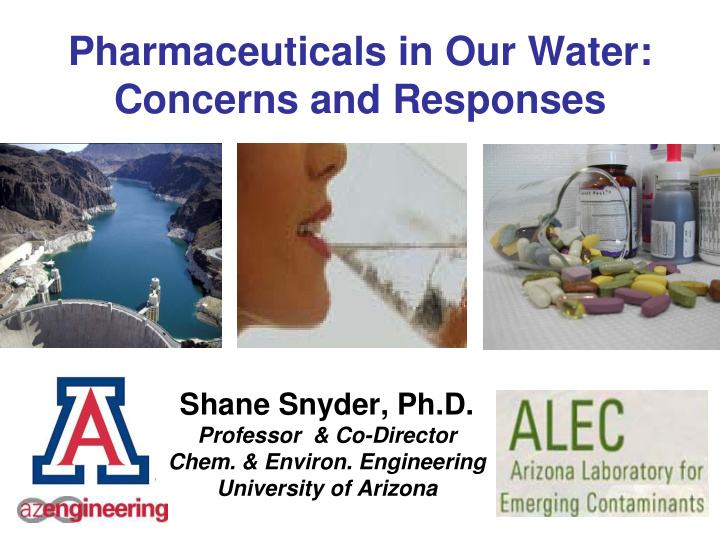



Pharmaceuticals in Our Water: Concerns and Responses Shane Snyder, Ph.D. Professor & Co-Director Chem. & Environ. Engineering University of Arizona
Key Points I. All water can be or will be reused II. Trace organic contaminants are ubiquitous in water III. Impacts to fish demonstrated, impacts to humans unlikely IV. Most efficacious treatment processes are energy intensive Lake Lanier, Georgia Lake Mead, Nevada
Water Reuse & Pharms Water Reuse & Pharms • All water on earth can/will be reused – Unplanned in many rivers – Planned projects growing rapidly • Water we drink is a vast minority – Generally <1% of home water use – Most used for washing/flushing • US population/urban growth stresses – ≈ new San Diego/year x 50 years – Highest growth in arid regions – Water reuse vital to sustainability • Human activities impact water quality – Nearly all compounds detectable – Artificial sweeteners & fragrances
Analytical Sensitivity Analytical Sensitivity • Pharms found in US water in 1970s – DOI report on hormones in 1970 – EPA report on pharms in 1975 – In water since pharms existed • Analytical methods are very sensitive – 0.000000001 g/L water routine – Imagine 1 second in 33,000 years – Nondetect ≠ zero ≠ safe – If ppb detection limits, no pharms – 3000+ pharms, which to monitor? • Survey of US drinking water 2000s – Water Research Foundation – Six pharms found, no hormones
Water Treatment Water Treatment • Water treatment processes effective – Chlorine transforms many pharms – UV light transforms many pharms – Ozone transforms most pharms – BUT, may increase toxicity • Membrane and carbon technologies – Reverse osmosis removes pharms – Activated carbon removes pharms • Advanced processes energy intensive • Disposal of waste streams and residuals • Operation can be complex and costly • Treatment goals should be health based, not detection based
Health Relevance Health Relevance • Feminized fish in US discovered in 1996 – Lake Mead below WWTP outfalls – 1997 estrogens linked (E2 & EE2) – Natural estrogens >> pharm – Since discovered globally (Potomac) • Rich human health data on pharms – Clinical testing and observation – Studies suggest conc. in drinking water not relevant to human health • Water “safety” paradigm challenged – EPA CCL and CA CEC pharms – Mixtures not addressed – Not all relevant biological endpoints
Implications Implications • Water reuse must be supported – Augments critical supplies – Reduces discharges to ecosystem • Fish impacts certain, humans unlikely – Fish and human exposure dissimilar – Fish cannot survive in most DW • Treatment solutions exist, but: – Many are energy intensive – Relocate or transform pharms • Since most water not consumed: – Strongly consider POU devices – Dual distribution systems – Household grey water systems
Research Needs Research Needs • Validated analytical methods – Indicator compounds for pharms – Pharms with greatest potency • Mapping water reuse in US waters – Wastewater contribution to DW – Locations of planned reuse • Use of bioassays for monitoring – Integrated measures of toxicity – Inclusive of transformation products • Holistic evaluation of cost/benefit – Energy and infrastructure costs – Life cycle analysis (WW vs. DW) – Goals established on health (eco & human)
For more information: For more information: Shane A. Snyder, Ph.D. Professor & Co-Director University of Arizona Arizona Laboratory for Emerging Contaminants snyders2@email.arizona.edu (520) 621-2573
Recommend
More recommend